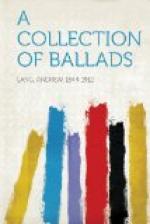Huntly had a commission to apprehend the Earl, who was in the disgrace of James vi. Huntly, as an ally of Bothwell, asked him to surrender at Donibristle, in Fife; he would not yield to his private enemy, the house was burned, and Murray was slain, Huntly gashing his face. “You have spoiled a better face than your own,” said the dying Earl (1592). James Melville mentions contemporary ballads on the murder. Ramsay published the ballad in his Tea Table Miscellany, and it is often sung to this day.
CLERK SAUNDERS
First known as published in Border Minstrelsy (1802). The apparition of the lover is borrowed from “Sweet Willie’s Ghost.” The evasions practised by the lady, and the austerities vowed by her have many Norse, French, and Spanish parallels in folk-poetry. Scott’s version is “made up” from several sources, but is, in any case, verse most satisfactory as poetry.
WALY, WALY
From Ramsay’s Tea Table Miscellany, a curiously composite gathering of verses. There is a verse, obviously a variant, in a sixteenth century song, cited by Leyden. St. Anthon’s Well is on a hill slope of Arthur’s Seat, near Holyrood. Here Jeanie Deans trysted with her sister’s seducer, in The Heart of Midlothian. The Cairn of Nichol Mushat, the wife-murderer, is not far off. The ruins of Anthony’s Chapel are still extant.
LOVE GREGOR
There are French and Romaic variants of this ballad. “Lochroyal,” where the ballad is localized, is in Wigtownshire, but the localization varies. The “tokens” are as old as the Return of Odysseus, in the Odyssey: his token is the singular construction of his bridal bed, attached by him to a living tree-trunk. A similar legend occurs in Chinese. See Gerland’s Alt-Giechische Marchen.
THE QUEEN’S MARIE—MARY HAMILTON
A made-up copy from Scott’s edition of 1833. This ballad has caused a great deal of controversy. Queen Mary had no Mary Hamilton among her Four Maries. No Marie was executed for child-murder. But we know, from Knox, that ballads were recited against the Maries, and that one of the Mary’s chamberwomen was hanged, with her lover, a pottinger, or apothecary, for getting rid of her infant. These last facts were certainly quite basis enough for a ballad, the ballad echoing, not history, but rumour, and rumour adapted to the popular taste. Thus the ballad might have passed unchallenged, as a survival, more or less modified in time, of Queen Mary’s period. But in 1719 a Mary Hamilton, a Maid of Honour, of Scottish descent, was executed in Russia, for infanticide. Charles Kirkpatrick Sharpe conceived that this affair was the origin of the ballad, and is followed by Mr. Child.
We reply (1) The ballad has almost the largest number of variants on record. This is a proof of antiquity. Variants so many, differing in all sorts of points, could not have arisen between 1719, and the age of Burns, who quotes the poem.




